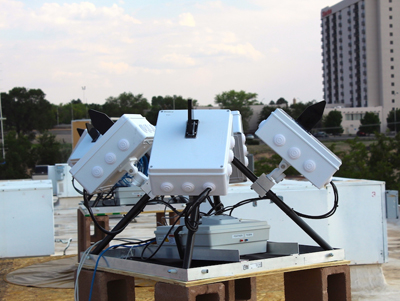ATLAS Space Operations announced the deployment of the first X-Band electronically steered array system — LINKS. Located in Albuquerque, New Mexico, the first-of-its-kind four-element array consists of 16 individual antennas.
Operationally, the four-unit LINKS system, which sits atop an office building, offers ATLAS customers similar capabilities to using a mid-sized parabolic antenna. With no moving parts, the system provides higher gain than a parabolic antenna, while simultaneously tracking multiple satellites at a time — reducing costs and scheduling conflicts for satellite operators.
Historically, space-to-ground communications have used a network of large and expensive parabolic dish antennas. These legacy systems can take up to months to install and deploy, creating a costly capital expenditure burden on the satellite ground network operators. Once these antennas are installed, they are fixed there for the rest of their serviceable lives.
LINKS was invented to alleviate all of these obstacles. LINKS is the paradigm-shifting alternative to traditional parabolic dishes, researched and developed by ATLAS. The system is the first commercially available, mobile, rapidly deployable, electronically steered array RF ground system in the world. The array, capable of S- and X-Band, automatically integrates into ATLAS’ proprietary Freedom software platform. Creating a software-defined antenna system capable of supporting SATCOM and other RF applications, such as detection, tracking and exploitation.
LINKS stands only 20 in. high and 26 in. from corner to corner. This design makes an agile, responsive system capable of providing high data flow in operationally-limited environments. The days of pouring concrete and building expensive mechanical pedestals are now a thing of the past. The four LINKS units deployed in Albuquerque took a single day to install, then linked to the Freedom software platform within seconds of activation.
Currently, ATLAS’ Freedom Network consists of 21 operational and planned antennas globally employing the proprietary Freedom software. The Freedom Network is capable of securely handling both commercial and U.S. civil spacecraft, enabling operators to communicate with their satellites and reducing capital expenditures at every ground entry point.
“I am extremely proud of the whole team at ATLAS for achieving this significant milestone. What it represents for the satellite industry is a complete departure from traditional space to ground communications. At ATLAS, we innovate to change the game. What we have delivered here is innovation where it’s needed most, finally giving the industry access to an electronically steered, multi-band, multi-satellite capable ground system. Some people in this industry have referred to this as the 'Holy Grail' of SATCOM. I view this achievement as a defining moment for ATLAS and, frankly, the entire industry. This is only the beginning.” — Sean McDaniel, CEO of ATLAS
“LINKS leverages leaps forward in computing and networking technology to eliminate the need for a large parabolic signal concentrator. We are witnessing first hand, an example of advancement in one technological field directly pollinating a leap forward in another area. While electronically steered apertures have been around for some time, this is a first-of-its-kind application, explosively widening communications options for current and future satellite operators.” — ATLAS Chief Engineer Steve Gaines

